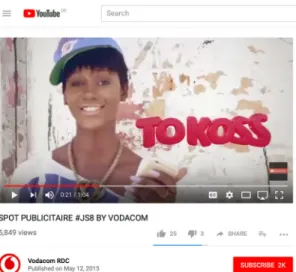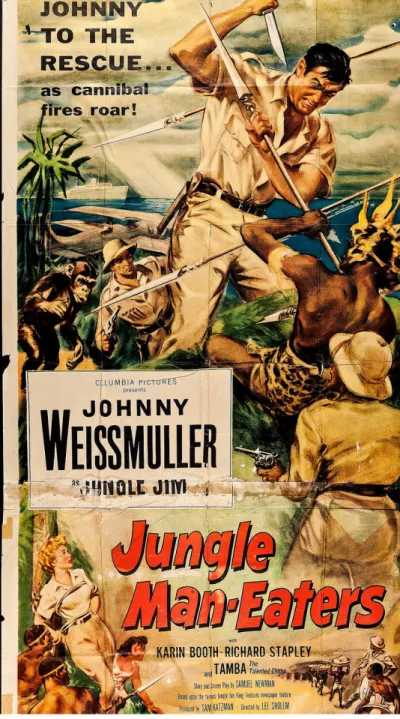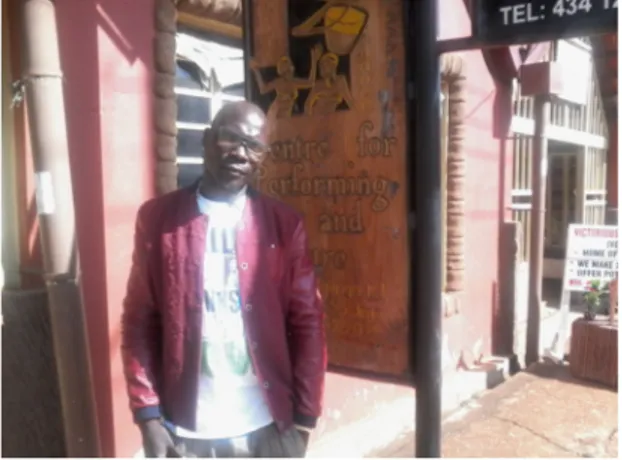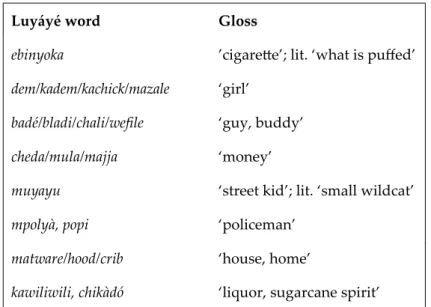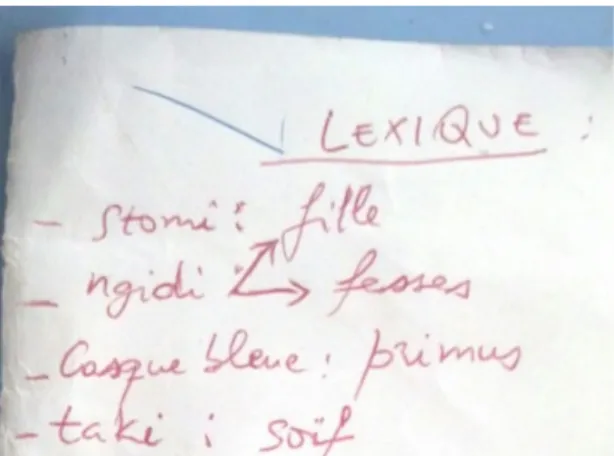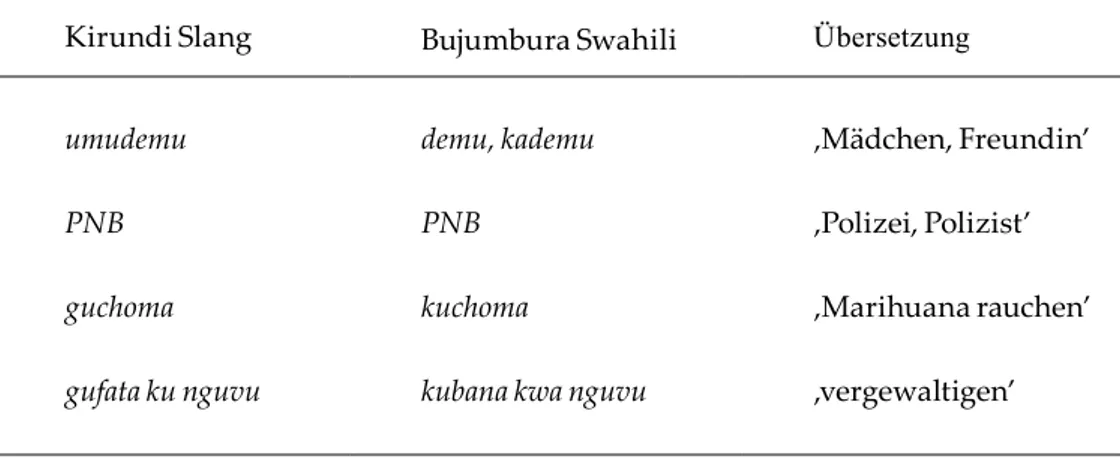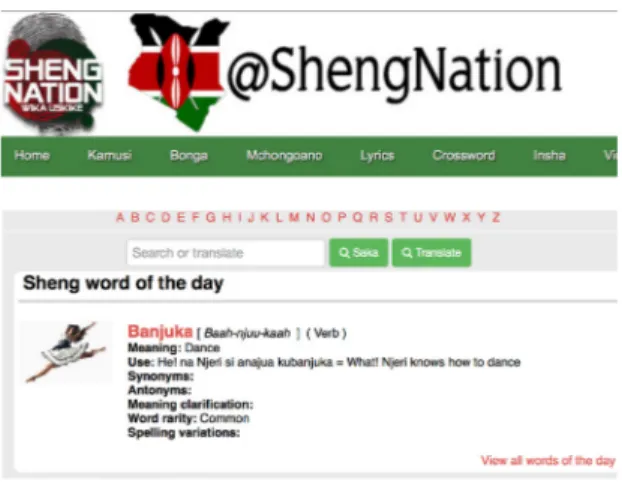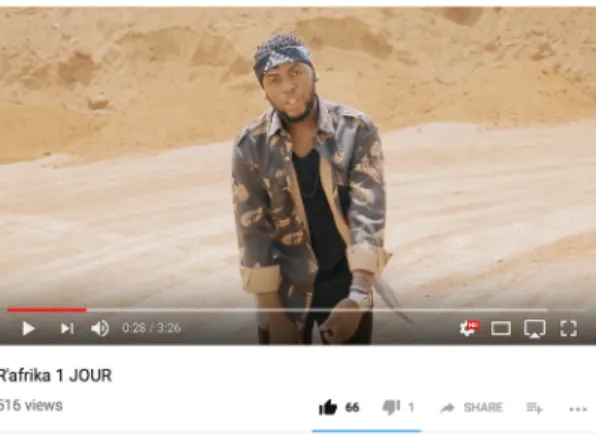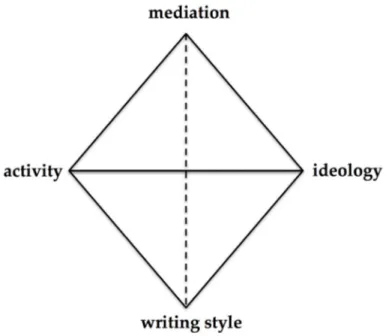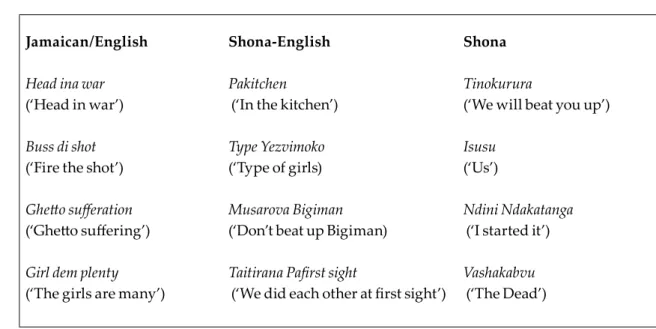RESISTANCE IDENTITY ANTILANGUAGE RASTA ATTITUDE ARADA RANDUK SHENG WHATSAPP SEXTING YANKÉ KINSHASA KINDUBILE URBAN RURAL
HILLBILLY LANGUE FASHION LANGILA DRUGS GANJA CRIMINALITY NON- STANDARD MANIPULATION LUGHA YA MITAANI SLANG SLANGUAGE
S’NCAMTHO TSOTSI BAYAAYE DEMU CAMFRANGLAIS CODESWITCHING TRANSLANGUAGING CREATIVITY FUN BAD LANGUAGE OFFENSIVE TABOO- BREAKING NAIROBI DICKPIC GENDER DAKAR WOLOF BILLS GODOBÉ
SOCIALMEDIAFAKE-TAGGING SECRECY SPEECH CITY/VILLAGE VILLAGEOIS HIP HOP EMOJI YANKÉE MESSY PERFORMANCE
PERFORMANCE ALCOHOL TOBACCO MUSIC ARTIST COMMUNITY OF PRACTICE ANALYSIS DIRTY HAIRCUT DANDY WAGWAAN LANGILA
NAIJA PIDGIN WAHALA INSTAGRAM SEX UNRULY EPHEMERALITY
CROSSING METROLINGUALISM YOUTH REGISTER ANTILANGUAGE TSOTSI
PHONOLOGY ABACRÂNE LANGILA SNCAMTHO STADTSPRACHEN METAPHOR WITCHCRAFT FASHION EMOJI LANGUAGE COMPETENCE PIDGIN NAIJA INSTAGRAM COMPETENCE LINGUISTIC CHANGE SEMI-
SPEAKER URBAN-DICHOTOMIESRESISTANCE IDENTITY RASTAARADA RANDUK S‘NCAMTHO WHATSAPP ING YANKÉKINSHASA KINDUBILE RURAL
HILLBILLY LANGUELANGILA DRUGS GANJA CRIMINALITY ARD MANIPULATION YA MITAANI SLANG SLANGUAGE TSOTS KINSHASA I CAMFRANGLAIS
CODESWITCHING TRANSLANGUAGING CREATIVITY FUN BAD LANGUAGE OFFENSIVE TABOO-BREAKING NAIROBI DICKPIC GENDER DAKAR WOLOF BILLS URBAN GODOBÉ-TAGGING SECRECY POA CITY/VILLAGE
HIP HOP EMOJI YANKÉE MESSY VOICE TOBACCO MUSIC ARTIST
COMMUNITYOF SPEECH ANALYSIS DIRTY HAIRCUT DANDY WAGWAAN
NAIJA PIDGINWAHALA UNRULY EPHEMERALITYCROSSING BRICOLAGE YOUTH REGISTER ARGOTVERLAN YABACRÂNE LANGILA HO STADTSPRACHEN CONCEALMENT MEDIATIZED OLOGY METROLINGUALISM SHENG
SEX IDENTITY CAMFRANGLAISMULTILINGUALISM MIXING MOTHER TONGUE NAIJA COMPETENC ESEMI-SPEAKER URBAN IDENTITY URBAN-RURAL-
DICHOTOMIESRESISTANCE IDENTITY ANTILANGUAGE RASTA ATTITUDE
Issue 3, July 2018
C ritiCal Y outh l anguage S tudieS –
r ethinking C onCeptS
Published with the generous support of
Imprint
Printed version of the 3rd issue of The Mouth
Editors:
Andrea Hollington, Nico Nassenstein & Anne Storch Technical support of the online edition:
Jan Peters Layout and design:
Frederik Weck Printing and binding:
Hundt Druck GmbH, Cologne ISSN: 2513-101X
CONTENT
02 „I swear they said this …”: Kritische Gedanken zu afrikanischen Jugendsprachen und ihren Beschreibungspraktiken
Nico Nassenstein
29
05 Transatlantic translanguaging in Zimdancehall: Reassessing linguistic creativity in youth language practices
Andrea Hollington
105 01 Disinventing and demystifying youth language: Critical perspectives
Nico Nassenstein, Andrea Hollington & Anne Storch 9
03 Silencing youth 65 Anne Storch
125 06 How to get information on Sango Godobé and the Godobé of Bangui:
A dialogue between Helma Pasch and Germain Landi Helma Pasch & Germain Landi
04 Digital writing practices and media ideologies of German adolescents 85 Florian Busch
173 09 Youth languages and the dynamics of language change: The story of aguu
and the Acholi youth language Leb pa Bwulu.
Steffen Lorenz
155 08 Language, European football fandom and social identification among
the youth in Eldoret, Kenya Solomon Waliaula
139 07 Tuk-tuk slogans in the coastal towns of Kenya: A glimpse behind
communication practices on three wheels Bonciana Lisanza & Angelika Mietzner
199 11 More than youth language: the multiple meanings of Yabacrâne in
Goma (DR Congo) Paulin Baraka Bose
12 Blurred lines 207 Nicolai Klotz
10 Youth language attitudes and secrecy in West Cameroon 183 Emmanuella Bih
Disinventing and demystifying youth language: Critical
perspectives
01
Disinventing and demystifying youth language: Critical perspectives
Nico Nassenstein, Andrea Hollington & Anne Storch Johannes Gutenberg-University Mainz/University of Cologne
nassenstein@uni-mainz.de andrea.hollington@yahoo.de
astorch@uni-koeln.de
01
1. From the margins
All texts have margins; the white strip of paper that engulfs a book’s chapters, an essay, or the manuscript of a talk. It has several purposes, such as providing the few centimeters that rea- ders need for their fingers and thumbs to hold the pages. Next to grasping and holding, the margins are for working with what is offered on the sheet of paper: a text. Reading, as an interaction with the text, can open communi- cation with the author, other readers and often with ourselves. We can then come to depend
on these marginal spaces in order to write on them ourselves. We can cover them with short remarks, notes, reminders, corrections, angry responses, happy responses or doubt.
These notes on the margins can even become
more important to us than the text itself. They
might turn our reading into a metasemiotic
discourse, a complex discussion of what
we have just seen or the draft of a paper that
we might now want to write ourselves. The
writing on the margins is almost always
precious, because it generally contains fresh
and spontaneous ideas (if we are lucky) and
creates an interaction with others, breaking the writer’s monologue. Yet, it is often critical and sometimes these written things remain in the margins because of this.
This volume, in some sense, has emerged from resorting to our own marginal comments and thoughts on those whom we, as linguists, often place in the marginal spaces of their or our society. These brief notes were the traces of our reading and spontaneous thinking and often seemed to highlight certain ideas;
suggesting that they should be brought out of the insignificant borderlines. Numerous contributions to the description and sociolin- guistics of youth languages offer explanations for the seemingly strange marginalization and subjugation of the subject. Youth languages are different because they are not part of main- stream linguistic practices; they are placed in the margins of communication. Yet youth is neither a marginal condition nor a rare phe- nomenon as such; the experience of coming of age is one that we all share. Our marginal notes often hinted that the essentializing and exoticizing representations of young people’s language practices are a problem. We could easily relate to youth and therefore asked in our handwritten comments for a critical reflec- tion on the marginality of a group to which we once all belonged.
2. Why critical?
Developing a more critical perspective appears to be a timely task. Is the object of our discussion – youth language – really marginal, remarkable and different? After all, what once appeared to be special knowledge about youths and in-group expertise of linguists, now appears to be common knowledge.
Just as youth is not a marginal condition, neither is youth language. Therefore, another overdue critical reassessment is needed to address the observation that youth languages have often been constructed as ‘special’
in terms of their linguistic creativity by linguists. By highlighting their strategies of manipulating ‘standard’ language, it seemed as though this kind of creativity was a special feature of youth language practices. In particular; rapid and highly skilled multilingual juggling, now often termed translanguaging (see below); semantic manipulations such as metaphor, metonymy and dysphemism; and phonological processes such as truncation, abbreviation or playful phonotactic changes have been illustrated with examples from many youth languages (see Kießling & Mous 2004, Nassenstein
& Hollington 2015, among many others).
However, the very same strategies are also employed by other speakers in a wide range of contexts. For example, translanguaging can be observed in numerous multilingual societies around the globe. Furthermore, semantic manipulations are a vital phenomenon in linguistic change and language evolution.
In fact, scholars in cognitive linguistics
such as Lakoff and Johnson (1980) have
illustrated that metaphor is a crucial cognitive
process through which our human mind
processes experiences; hence metaphor is
pervasive in everyday language. Likewise,
phonological manipulations are found in
many different contexts from colloquial speech
to advertisements and politics. In this regard,
it needs to be acknowledged that linguistic
creativity is a widespread, common and
everyday phenomenon in language use and not
special to youth languages (see Carter 2004).
The current construction of youth lan- guage as exceptional and specially creative is an undertaking not only by linguists, but also by the wider society. This becomes evident when looking at the appropriation of youth language practices in popular discourses. In many instan- ces, the exoticization of youth languages can be observed when youth language is commo- ditized and commercially exploited in popular media such as advertisements or movies.
This often incorporates a static presentation of extracts of the fluid practices of youth. With regard to African contexts, the movies Tsotsi (2006), Nairobi Half Life (2012) and Kinshasa Kids (2012) (see Fig. 1–3) are examples of urban youth representations. In these movies, semi-crimina- lized adolescents portray the daily struggle for survival in the three African megacities Johan- nesburg, Nairobi and Kinshasa, while several young protagonists’ rely on creative bricolages in order to make a living.
11 For a commercial appropriation of German youth language practices see for instance Fack Ju Göhte (2013).
However, all three movies, despite their good reviews, shared an inherent linguistic problem. The African youth language practices that they all, to some extent, exhibit; Tsotsitaal (South Africa); Sheng (Kenya) and Yanké (DR Congo), were reproduced, stylized and mostly decontextualized in order to create authentic settings for the three storylines of the respec- tive productions. This was mostly actualized by non-speakers of these languages; targeting assumed non-speaker consumers of the movies and their stylized language. This con- sequently turns fluid linguistic practices into artefacts and thus into popular commodities of the movie industry. Interestingly, the viewers seem to have understood the languages used in these movies, which were successes among diverse audiences.
Yet, the commodification of youth lan- guage is not limited to the production (and consumption) of movies, but can also be seen in the academic artefactualization of youth language presented at conferences, workshops and published in papers and monographs.
Fig. 1–3. Tsotsi (2005), Nairobi Half Life (2012) and Kinshasa Kids (2012)
This has been gaining increased attention not only as recent field of study but also as a way of generating funding and boosting careers.
The study of African youth language prac- tices, for example, is an academic field of study which took a more concrete shape in the years after the millenium, and has hitherto produced a large body of scholarly work (following Kieß- ling & Mous’ 2004 paper; for an overview see Nassenstein & Hollington 2015, Mensah 2016).
Most of the studies, corpora and analyses have been treated as innovative studies and were largely focused on practices described as urban phenomena. Despite the variability of labels,
‘slang’, ‘slanguage’, ‘youth slang’, ‘teen talk’,
‘anti-language’, ‘UAYL’, etc. employed for the practices that stand in the center of attention of linguists, there is a recurrent list of features that most youth languages (and their spea- kers) allegedly share, which will be critically reanalyzed in the present volume.
2Instead of providing precise new directions, we would like to raise certain general questions:
• How can we ‘unlearn’ the consideration of language as a totalitarian concept and rather think of youth language as part of fluid, messy, multifaceted practice;
building upon holistic, embodied work instead of wordlists, corpora and gram- matical analyses?
• What does a non-disciplinary approach to youth language look like?
2 It may be important to note that the critical view on youth language studies does not aim to emphasize shortcomings in our colleagues’ work but has an intrinsic self-reflexive motivation. By firstly looking at our own research results and published works, we came to the conclusion that a more critical stance is needed. We are indebted to our colleagues whose comments and ideas have largely contributed to this volume: Janine Traber, Janosch Leugner, Ana Deumert, Nkululeko Mabandla. Kieran Taylor is warmly thanked for carefully correcting our style and English.
• How can we reflect upon established aca- demic practices, such as looking at youth language as a form of non-conformity in language instead of focusing on youths who use language in more conventional ways (or remain silent)?
• How can we create a holistic account of language ideologies and concepts that investigates the ideologies of speakers as well as those of scholars?
• How can we successfully consider youth language practices as a process rather than fixed varieties?
• Which other views on youth language, for example grassroots practices, are possible?
• How can we incorporate writing prac- tices and youth agency in digital media?
• Which forms of contributions, apart from written academic essays, can shed light on the phenomena from other angles?
3. Rethinking language, reassessing data
Collected data on youth language, such as
wordlists, short conversations, ethnographic
notes and metalinguistic comments, are
often more reminiscent of a performed stage
play than of natural speech and everyday
interaction. The data presented in scholarly
papers and (the few) monographs available often draws a static picture of an exoticized or humorized form of language, which is deviant and abnormal. This is precisely one of the points we aim to raise in this issue: in order to be demystified, youth language first needs to be seen as a type of ordinary everyday lan- guage; neither bound to a specific age group, nor to resistance identities or necessarily serving the means of an “anti-language”
(Halliday 1976). This broader dichotomy can be seen in the labeling of such speech styles as
“contemporary urban vernaculars”, suggested by Rampton (2011), which no longer necessa- rily bounds a linguistic style to age or specific social groups. This concept was then later picked up by Aarsæther et al. (2015) for groups of (young) people in Belgium and Norway.
Our own work has shown that in African city contexts, but also towns and villages alike, youth language can be employed by midd- le-aged or elderly people in all kinds of situati- ons. Elsewhere, we (Hollington & Nassenstein forthcoming) state that youth language prac- tices like Yanké (sometimes called Lingala ya Bayankée) from Kinshasa have undergone an increasing social spread. In the case of Kin- shasa, Yanké has spread all across the capital city; employed in music; advertising; and in young and old people’s interaction. It is used mockingly, playfully, or simply as one of many linguistic options in the urban linguascape of Kinshasa. Figure (4) illustrates an example of the language taken from an advert of a Congolese phone company; in which the net- work (and offer) is described as tokoss, derived from Lingala kitóko (‘beautiful’). Often having been associated with youth language, tokoss
3 See [https://www.youtube.com/watch?v=Qva2CJHfr3w&app=desktop] (accessed 29 June 2017).
nowadays represents an exclamation found all across Kinshasa, no longer restricted to adole- scents (if it had ever been restricted to youths at all, of which we are not certain).
Fig. 4. A video advert, praising a phone network as tokoss (‘beautiful’)3
‘Youth language’, in this case, turns into
a strange contradictory term that denotes the
deviant in language, or rather what language
professionals – linguists, language planners,
teachers, writers – consider deviant. From a
particular point of view, a word such as tokoss
is ‘not normal’. Yet it is widely used and very
visible, for example in advertisements placed
on built landscape and in the digital space. Due
to both linguistic landscapes and digital forms
of communication tending to be conceptuali-
zed as ‘urban’, such linguistic practices become
quickly categorized as ‘urban vernaculars’ and
enregistered as ‘youth languages’. However,
we must question whether this is the only
enregisterment that takes place. Isn’t the ideo-
logical construction and conceptualization of language practices more complex and multiple rather than simplistic? We suggest a more reflected analysis here: hegemonic language concepts need to be seen as coexistent with others; for example, just as tokoss, as a linguistic entity, might in a certain context be part of practice enregistered as ‘youth language’, in other contexts, within Kinshasa’s large and complex linguistic market, this practice might be enregistered as ‘local’. This concerns lan- guage as a concept; language practices and lan- guage ideologies are decidedly dynamic and multiple, things that can never be told as single stories but emerge as a kind of idea of reality through diverse and often messy stories.
4. Reconsidering methodology in complex settings
Critical thought on the commonly applied methodology of youth language studies is, however, not entirely new. The concepts raised in this volume form
the basis for further critical approaches, mostly with a focus on African language practices and linguistic pre- sences (with the exception of Busch’s contribution). In two recent publications, Beyer (2014, 2015) raises the point that very few studies are based on immersion field- work of linguists who spent a longer period of time in the respective communities.
Moreover, he states that very little ethnographic data is available, as most studies are,
in general, based on short (and often typo- logical) overview descriptions which reveal little of the actual reality of speakers and their social interactions. Only a handful of more extensive ethnographic studies have, so far, provided more profound insights (for Sheng, see for instance Wairungu 2014).
Another general problem is the tendency towards bird’s eye views of languages; evident in the discussion of Sheng and Co. Map 1 shows the classification of Sheng in Maho’s (2009) updated list of the Bantu languages, based on a classification by the Bantuist Malcolm Guthrie. In accordance with other Kiswahili dialects (an overview can be found in Möhlig 1995), Sheng has received a letter-number combination G40E. In this particular case it can be seen that fluid urban practices seem to be turned into “‘new’ languages in the Bantu area” (Maho 2009: 96).
Map 1. Sheng (G40E) and Engsh (G40D) according to Maho (2009: 96)
Counting languages and considering youth language practices as new languages or varieties of existing languages, seems to be a common Africanist take on youth language, grounded in the discipline itself. Hurst, who provided important insights especially in Tsot- sitaal speakers’ (linguistic and non-linguistic) stylistic aspects (in her monograph from 2008), also mentions specific varieties:
[A]ll of the official languages in South Africa (11 in total) have their own accompanying tsotsitaal.
Other non-official languages, including mixed forms of language in highly multilingual town- ships such as Soweto, also have their variety of tsotsitaal. (Hurst 2015: 169)
A second map, provided by Kioko (2015:
131) shows no dialectal differences ascribed to
specific Kiswahili-based linguistic practices but differentiates between varieties of Sheng as spoken in different neighborhoods of Nairobi.
There are certainly different ways that predo- minant ethnic groups speak Sheng in certain neighborhoods, however mapping them geographically does not seem to be the most suitable method to illustrate the broad variabi- lity of Sheng. This is due to the fact that Map 2 resembles maps based on isoglosses (Möhlig 1995) rather relating to sociolinguistic factors of migration and urban settlement. Yet it is evi- dent that Kioko’s studies enrich the discussion on Sheng with important new insights. For instance, based on his observations, he shows that Sheng, along with other youth language practices, does not necessarily have to be an
“interethnic bridge” (Kießling & Mous 2004:
315) for speakers but can rather be subject to ethnic negotiations, or “competing identities”
(Kioko 2015: 128).
Map 2. Different varieties of Sheng (Kioko 2015: 131)
While the model of European ‘multie- thnolects’ in cities of the Global North (such as Rotterdam, Stockholm, Brussels and Berlin) points in a similar direction to the idea of interethnic language practices in the Global South, Sheng, Yanké etc. often still reflect colo- nial language policies focusing on so-called
“tribalism”. In reality they are by no means homogenous entities that can be easily labe- led, documented and then considered as “new languages” (cf. Maho 2009).
4In his extensive study on Sheng, Wai- rungu (2014) describes the impact of his own Kikuyu identity on the research situation and his interethnic relationship with the Sheng speakers he interviewed. Not only the delicate role of the researcher’s and his/her interlocut- ors’ ethnic affiliations become obvious in this example, but also the observer’s paradox (see Nassenstein, this volume).
My regional and ethnic identity also affected the way I interacted and perceived my informants.
Some of their narratives about the 2007 post-elec- tion violence projected Kikuyu as a threat to other ethnic communities in Kenya, hence potential targets during ethnic clashes. This identity threat was true in Nakuru as was in Mombasa, where people from upcountry, especially Kikuyu, were targeted for elimination by the communities that perceive themselves as coastal. Some of these
4 Linguists often streamline and/or ignore divergent labels for youth language practices, as also expressed by Wairungu (2014: 78), saying “that speakers use different labels to refer to practices that are hard to distinguish linguistically”. He gives the example of Sheng speakers who decide to name their language Heng, and also refers to the difficult task of linguistically differentiating between Nairobi Swahili and Sheng. Another example is the (still very prominent and popular) label Indoubil/
Hindoubill for youth language(s) from DR Congo, despite the fact that Yanké and Langila speakers reject this language name, treating it as an antiquated relict. The practices of Kindubile in Lubumbashi (Mulumbwa 2009) and Kindoubil in Kisangani (Wilson 2012), however, have retained modifications of this label. The act of linguists giving youth language practices fixed labels (see for instance also Nassenstein, this volume) forms part of an artefactualization of linguistic practice (see also Lüpke & Storch 2013).
narratives were very frightening because they were about how informants experienced the 2007 post-election violence as perpetrators or as victims. Such narratives hurt my emotions and affected the way I perceived the narrator. (Wai- rungu 2014: 43–44, our emphasis)
Yanké was initially described as “inter- ethnic” by speakers, however the inherent ethnic tendencies of the language became clear once speakers got acquainted with Kioko’s recent findings on Sheng:
On se moque vraiment de l’ethnicité de l’autre. Quand un autre… vous êtes dans la rue, un autre est en train de parler, les natifs de Kinshasa ont leur accents, par rapport à comment ils discutent dans le langage de jeunes. Exemple, si tu te trouves avec des enfants dans le rue qui viennent de Kananga [Kasai province, speaking Cilubà]: Ils vont parler dans un accent la, d’autres vont commencer à rigoler, et qui vont leur [sic] nommer, leur coller des noms, exemple “tatu, eh, tatu!” Tatu, ça signifie comme ‘papa’, maintenant on va leur coller par rapport à leur tribus [sic], par rapport à leur ethnicité. Même s’il est jeune, on commence directement à l’appeler tatu. Okay, pour les Baswahili [eastern DR Congo, speaking Swahili], on les appelle minasema. “Minasema, eh, ah, bínó, ba-faux-jeunes, ba-minasema.” On tire de leur ethnicité, des “kadogo, kadogo, yáká!”
[We really mock each other in terms of one’s ethnicity. When one… you are in the streets, another one speaks, Kinshasa natives have their accents, according to how they discuss in youth language. For example, if you are with children in the streets, the ones who come from Kananga [Kasai province, speaking Cilubà]: They will speak with an accent, others will laugh, they will call them names, attach names to them, for example tatu, “oh, tatu!” Tatu, that means ‘daddy’
[in Cilubà], now they attach a label to them according to their tribe, their ethnicity. Even if he is young, one starts directly to call him tatu.
Okay, for the Swahili people [eastern DR Congo, speaking Swahili], one calls them minasema [I say]. “Minasema, ah, you guys, fake youths, the minasemas.” You pull them by their ethnicity, the ones of “child soldier, child soldier, come!”
(Carter Omende, 2016, our emphasis)
We can consequently question whether the original statement may have been due to the linguist’s insinuating questions, or metho- dology. Not only the role of ethnicized spea- king practices has to be reconsidered, but also concepts of urbanity (vs. rurality?), resistance identity, youth language as anti-language, and many more.
5. Sociolinguistic trends and academic hierarchies
In current sociolinguistic theory, the concepts of translanguaging (García & Wei 2014), poly- languaging (Jørgensen et al. 2011) and metro- lingualism (Pennycook & Otsuji 2015) (to name those most cited) grasp fluid approaches to
5 For some exceptions, see Nassenstein & Hollington 2016 on fluid “global repertoires” and Tacke-Köster 2016 on a metrolingual understanding of Kirundi Slang.
multilingualism. These are also summarized by Pennycook (2016) under the label of a “trans- super-poly-metro movement”. However, these concepts have, so far, rarely been applied to African youth language practices
5and in most cases more conventional approaches, such as code-switching, still range among the most commonly employed theoretical frameworks (see Ogechi 2002, among others). This reflects a divide in the debates surrounding theories from different (socio)linguistic academic environments and among different intellectual movements. Theoretical models, like those mentioned above, tend to gain momentum purely because they are developed and discussed with reference to several colonial and globalized languages. This is of interest and relevance to the majority of influential scholars in the field who are based at northern universities or included in metropolitan and exclusive networks. Those whose institutions, competences and interests are elsewhere, at less visible institutions, in languages shared by lesser numbers of people, or on topics well out- side mainstream linguistics, do not get invited to contribute to high-profile theory making (unless as validators of something already established), and they are not taken seriously as independent thinkers of different ideas and theories. We probably use the label of ‘youth language’ for deviant practices because we lack any adequate theoretical approach that could lead us to more high-profile models instead of banal conclusions.
This is arguably best exemplified by citing
yet another theoretical framework that has
moved increasingly into the academic focus:
namely the discussion of superdiversity (based on Vertovec 2007) as a popular concept to explain complex diversified urban spaces. The diverse linguistic landscapes and soundscapes of European cities, among others, have become focal to sociolinguists seeing diversity not so much as static linguistic variations, but as dynamic processes (e.g., Matras 2009). But how helpful is this concept in the study of (very diverse/diversified) youth languages really?
The concept of superdiversity (Blommaert 2013, Rampton et al. 2015) is often associated with “late modernity” or “liquid modernity”, which, according to Bauman (1999), is charac- terized by nomadic trajectories; ever-changing workplaces; values; and the loss of traditional networks, supposedly representing a novelty in contemporary societies in the Global North.
In African societies, for example, the dynamics that constantly unfold through the cultural practices of building relationships, being immersed in social environments of different kinds, and being in motion (symbolically, phy- sically, philosophically, linguistically) is often a crucial, yet banal, aspect of life (e.g., Mietzner
& Storch 2015). This questions how remarka- ble superdiversity is from an African, or for instance, Oceanian perspective.
Another view on youth language prac- tices, and the deviant in language is possible.
Refocusing with a postcolonial perspective and historicizing such language practices within their context, we see that they often emerged in or toward the end of colonialism.
6We therefore suggest that youth language can often be seen as a kind of mimetic play in postcolonies. This can be explained by taking
6 See the supposed emergence of Tsotsitaal in the 1930/40s in Sophiatown, Soweto (Glaser 1990), Sheng in the 1930/40s in Nairobi, and Yanké in the late 1950s in the struggle for independence in Léopoldville/Kinshasa (Gondola 2009).
a closer look at the hip hop artist “Jungle de Man-Eater” from Jinja in eastern Uganda.
Having created a new hip hop style (Lusoflo) held in the local Bantu language Lusoga,
Fig. 5. Jungle Man-Eaters (Columbia 1954)
“Jungle” plays with names (see Figures 5-6), concepts, and different styles of language.
He mixes conventional Lusoga language, proverbs and songs which he picked up from conversations with elders, with Lusoga youth language, that he calls Luyáyé in analogy with the Luganda-based youth language Luyaaye from Kampala (see Namyalo 2015, 2017).
Fig. 6. The Ugandan artist Jungle de Man-Eater7
However, instead of seeing himself as a non-conformist or ‘youth language speaker’, research subject, “Jungle de Man-Eater”
explained to us that he was a researcher. He positioned himself as an embodied marginal protagonist, who would walk around at night and actually collect youth language (Jungle de Man-Eater, pers. comm. 2015):
I collect words that create stories for me, with my notebook, I write them down or ask for their meaning. I go to local bars at night, where the guys stand outside and sell weed, or waiting for somebody. They are never sober, they know
7 Based on a form of postcolonial mimesis, Jungle’s name with a clear reference to Lee Sholem’s movie from 1954 summarizes the critical voice of his hip hop lyrics, in which the European fear of a ferocious Africa is a recurrent trope.
stories. They see the sluts. I go around smoking cigarettes, I am everywhere. I talk to girls, buy her a drink, and I chat in Lusoga, to show that now not only Luganda is a language of money. People then start getting free! I record words with my phone, I am an urban researcher. But I also go to villages, collect proverbs from elders, idioms, and I ask them ... how to write them.
This can be seen as not only considerably interesting for an understanding of linguistic innovation, but especially in terms of the binary social relations and clear hierarchy that youth language research often produces (experts vs. speakers, researchers vs. observed object). The Ugandan hip-hop artist seemed to turn these relations around; providing a slightly different, playful copy of northern researchers’ practices (see Taussig 1999 on the concept of mimesis), as a stylistic bricolage of conformative and non-conformative language.
An afternoon spent with Jungle in Jinja developed into notated lists of Luyáyé words, which he had scribbled earlier in his notebook, collected during one of his nocturnal strolls.
It is very interesting to observe that these notes did not differ from the neatly arranged, translated and semantically grouped wordlists in our fellow academics’ short overviews of Yabacrâne, Lugha ya Mitaani or Kirundi Slang.
Our aim is thus to understand youths’ cre- ative and manipulative means of language no longer as sociolectal deviations but as agency.
Youth language can, when seen from a post-
colonial angle and drawing upon what now is
increasingly referred to as Southern Theory, be
understood as power, magic and damnation
(see also Storch 2011 for a discussion of youth language in analogy with other forms of agentive and powerful language). Street children in Kinshasa, often expelled from their homes and considered to be bewitched (see also De Boeck 2004), employ youth language in practices of cursing others and in doing so turn their marginalized roles into powerful agency through threats related to cannibalism, brutality and murder. Street children become the ultimate
Other, the vampire and cannibal, and bragging about this constitutes a way of constructing the Other’s Other. A former street child from Kin- shasa narrated an incident in which he threat- ened an adult thief, by ‘using power’, referring to powerful language which would intimidate and threaten his interlocutor:
J’ai appliqué la force: Eh, zóngisá lar wâná, na’obá- kisela yó. Sókí oyébí nga té, nakodamé yó, na’â vrai yanké, yakuza!
[I used force/power: Oh, give back that money, I will add you something [else] to that. If you don’t know me, I will devour you, I am a real Yanké, a Yakuza!] (Carter Omende, Kinshasa, 2016)
In this case, language is not only a fashio- nable item, or humoristic and creative expres- sion for the street youth, but can affect and alter power relations between speakers and listeners; between the marginalized and the societal excluders. Yanké reveals a considera- ble number of specific lexemes related to witch-
craft, exorcism and a deuxième monde; it could be justifiably categorized as a language of sorcery, spirits and witchcraft. A range of scho- lars already stress that young people’s “agency often arises out of the way in which they are capable of crossing and recontextualizing the boundaries between seemingly contradictory elements” (De Boeck & Honwana 2005: 10).
Playing with pain and pleasure, they can be seen as stuck between the worlds of the living and the dead, representing vulnerable beings and at the same time violent actors (cf. ibid.).
This ambivalent role of African youths could be used as an example to help broaden the view of youth language, reconsidering speakers’
linguistic choices in their postcolonial context.
Youth language practices are surely diverse and can be taken as examples of a broad diversification of languages, but they also reveal a high degree of critical reflexivity.
‘Speaking back’ and ‘speaking youth language’
can be understood as critical performances in the postcolony and beyond: resistance, as
Luyáyé word Gloss
ebinyoka ’cigarette’; lit. ‘what is puffed’
dem/kadem/kachick/mazale ‘girl’
badé/bladi/chali/wefile ‘guy, buddy’
cheda/mula/majja ‘money’
muyayu ‘street kid’; lit. ‘small wildcat’
mpolyà, popi ‘policeman’
matware/hood/crib ‘house, home’
kawiliwili, chikàdó ‘liquor, sugarcane spirit’
Table 1. Jungle’s collected Luyáyé words
represented by youths’ stylized linguistic practice, rooted in imperial formations and contradictory globalized or local arenas where multiple and divergent language ideologies co-exist. Mimetic interpretations of adolescent speakers target a colonially-based episte- mic hegemony, functioning beyond mere creativity and run to challenge authoritative systems of knowledge productions and global inequalities. Power, agency and ownership are expressed through powerful language, taboo-breaking, linguistic secrecy and also chaos. There is a creative play with non-stan- dard language and anti-normative enregister- ment, however this is only one of the central aspects of youth language practices.
6. About this volume
The discussion in this introduction outlined a few ideas of alternative approaches to youth language. The papers collected in this special issue each shed light on various aspects of youth language and thus enrich the study of such phenomena through critical methodo- logy, perspectives or theoretical implications.
Breaking away from classical linguistic approaches and offering alternative perspec- tives also means including various formats and ways of writing. This broadens the view on language as it not only includes the typical papers in academic writing style and thus makes other voices possible.
Critical self-reflection and a reanalysis of his own research practices on youth language from Burundi, Kenya, DR Congo and Uganda marks the focus of Nico Nassenstein’s paper.
By discussing several crucial aspects of his own work; such as the observer’s paradox; the danger of artefactualizing youth language
practices; or the common dichotomist view of language as being either urban or rural, he suggests critical and more actor-centered per- spectives on youth and youth language.
A new access to the topic, portraying and discussing youth and embodiment is pre- sented by Anne Storch. She uses her creative critique to engage the reader in new perspec- tives on youth language by deconstructing stereotyped images of “youth”. Suggesting a more holistic approach to youth language, the author discusses African practices in postcolo- nial contexts and illustrates that youth are not (only) what linguistic scholars believe them to be. This is achieved through the example of the Atikulate movement in Nigeria and a discussion of young peoples’ self-portrayal and self-expression.
A different take on language ideologies and digital communication is offered by Florian Busch, who discusses the digital writing practices of young adolescents in Germany. By investigating digital registers of writing, the author introduces the concept of media ideologies and presents a new model for the study of writing registers in digital spaces.
By analyzing examples from WhatsApp, he also examines young peoples’ metadiscourse practices as part of their communicative practices.
Another critical perspective on previous
studies of youth languages is offered by And-
rea Hollington. She aims to deconstruct the
notion of youth languages as ‘exceptional’, in
terms of their creativity. By discussing young
Zimbabweans’ linguistic practices in Zim-
dancehall, she shows that the same linguistic
strategies are also found in other contexts and
employed by other speakers. Moreover, she
sheds light on transatlantic dimensions of
youth language practices in music to supple- ment the empirical work.
The paper contributed by Helma Pasch and Germain Landi constitutes yet another approach to youth language: In the form of a dialogue between the two researchers, the article discusses how research on Sango Godobé (CAR) was undertaken. Scrutinizing the fieldwork practices (with results published in Pasch & Landi 2015), the paper, in inter- view-style, addresses a number of issues related to the practical implementation of research methods. Revealing personal expe- riences during research on Sango Godobé, the authors present an intimate discussion on how linguistic data was obtained.
In their work on language and tuk-tuks in coastal Kenya, Bonciana Lisanza and Angelika Mietzner analyze painted words and images as personal stories of mostly young drivers.
Grouping the slogans on tuk-tuks according to different identity-related categories, they show that the perception of creative words on vehic- les as a “youth register” is mainly an external ascription, while owners and drivers may seek to express something very different.
Solomon Waliaula explores language practices of young people in Eldoret, Kenya, by focusing on a special domain of communi- cation. He investigates the language of Euro- pean football fandom in Kenya and analyzes conversations of fans. His study hints at the problematic nature of the category “youth”
and, following a discourse-oriented approach, shows how fans use language to gain social prestige and to create and deconstruct football myths. Further, it becomes evident that Sheng, as a Kenyan youth language, does not always play a predominant role in young speakers’
interactions.
Emmanuella Bih’s paper introduces youth language practices in Cameroon from a different angle. By incorporating dialogues of conversations involving youths and family members of the older generation, she demysti- fies some of the common assumptions of Afri- can youth languages with regard to secrecy.
As she focuses on language practices in Ang- lophone Cameroon (as opposed to the much studied Camfranglais of the French speaking part of the country), she also sheds light on aspects of identity and generational change by illustrating how language is connected to music, clothing and hairstyle.
Youth language practices in northern Uganda are the subject of Steffen Lorenz’ con- tribution. The author introduces the language practice from Gulu and describes its origins, its spread and its linguistic innovations. His analysis is embedded in a discussion of the speakers and their social contexts, as well as including the consideration of power notions in language developments.
In his critical analysis of the Yabacrâne phenomenon in Goma, eastern DR Congo, Paulin Baraka Bose shows that a label initi- ally given to a youth language practice can actually have multiple social meanings and is not necessarily restricted to a specific way of speaking, nor to stylized language. By offe- ring an overview of the different meanings of Yabacrâne in Goma, he questions the academic study of African youth languages, the proces- ses of knowledge production and encourages alternative approaches.
Nicolai Klotz, as sort of an afterword to
the present issue, presents another alternative
view on youth language practices: His photo
series illustrating graffiti art on a wall in Swa-
kopmund, Namibia, mainly speaks for itself.
The pictures reveal communicative practices which involve language, art, slogans, imagery and metaphor and which often serve as com- ments on social issues, as motivators or advice for social and political behavior.
References
Aarsæther, Finn, Stefania Marzo, Ingvild Nistov & Evy Ceuleers. 2015. Indexing locality: Contemporary urban ver- naculars in Belgium and Norway. In Jacomine Nortier & Bente A. Svendsen (eds.), Language, Youth and Identity in the 21st Century: Linguistic Practices across Urban Spaces, pp. 249–270. Cambridge:
Cambridge University Press.
Bauman, Zygmunt. 1999. Liquid Modernities.
London: Wiley & Sons.
Beyer, Klaus. 2014. Urban language research in South Africa: Achievements and chal- lenges. Southern African Linguistics and Applied Language Studies 32.2: 1–8.
Beyer, Klaus. 2015. Youth language practices in Africa: Achievements and challenges. In Nico Nassenstein & Andrea Hollington (eds.), Youth Language Practices in Africa and Beyond, pp. 23–50. Berlin: Mouton de Gruyter.
Blommaert, Jan. 2013. Ethnography, Superdi- versity and Linguistic Landscapes: Chron- icles of Complexity. Bristol: Multilingual Matters.
Carter, Ronald. 2004. Language and Creativity.
The Art of Common Talk. New York:
Routledge.
Dagtekin, Bora. 2013. Fack ju Göhte. Berlin: Rat Pack Filmproduktion.
De Boeck, Filip. 2004 On being Shege in Kinshasa: Children, the occult and the street. In Theodore Trefon (ed.), Rein- venting Order in the Congo: How People Respond to State Failure in Kinshasa, pp.
155–173. London: Zed Books.
De Boeck, Filip & Alcinda Honwana. 2005.
Introduction. In Honwana, Alcida &
Filip de Boeck (eds.), Makers and Breakers:
Children and Youth in Postcolonial Africa, pp. 1–18. Trenton, NJ: Africa World Press.
García, Ofelia & Li Wei. 2014. Translanguag- ing. Language, Bilingualism and Educa- tion. Hampshire/New York: Palgrave Macmillan.
Gitonga, David. 2012. Nairobi Half Life. Berlin:
One Fine Day Film.
Glaser, Clive. 1990. The mark of Zorro: Sexu- ality and gender relations in the Tsotsi subculture on the Witwatersrand, 1940–1960. Paper presented at the Wits History Workshop: Structure and expe- rience in the making of Apartheid, 6–10 February 1990. [http://wiredspace.wits.
ac.za/handle/10539] (accessed 14 March
2018).
Gondola, Charles Didier. 2009. Tropical Cow- boys: Westerns, Violence, and Masculi- nity among the Young Bills of Kinshasa.
Afrique & Histoire 7: 75–98.
Halliday, Michael A.K. 1976. Anti-langua- ges, American Anthropologist 78.4:
570–584.
Hollington, Andrea & Nico Nassenstein.
Forthcoming. From the hood to public discourse: The social spread of Afri- can youth languages. Anthropological Linguistics.
Hood, Gavin. 2005. Tsotsi. Sandton: Industrial Development Corporation of South Africa.
Hurst, Ellen. 2008. Style, Structure and Function in Cape Town Tsotsitaal. University of Cape Town: PhD dissertation.
Hurst, Ellen. 2015. Overview of the tsotsitaals of South Africa; their different base lan- guages and common core lexical items.
In Nico Nassenstein & Andrea Holling- ton (eds.), Youth Language Practices in Africa and Beyond, pp. 169–184. Berlin:
Mouton de Gruyter.
Jørgensen Jens Normann, Martha Sif Kar- rebæk, Lian Malai Madsen & Janus Spindler Møller. 2011. Polylanguaging in superdiversity. Diversities 13.2. [www.
unesco.org/shs/diversities/vol13/issue2/
art2] (accessed 14 April 2018).
Kießling, Roland & Maarten Mous. 2004. Urban youth languages in Africa. Anthropologi- cal Linguistics 46.3: 303–241.
Kioko, Eric. 2015. Regional varieties and ‘ethnic’
registers of Sheng. In Nassenstein, Nico
& Andrea Hollington (eds.), Youth Lan- guage Practices in Africa and Beyond, pp.
119–147. Berlin: Mouton de Gruyter.
Lakoff, George & Mark Johnson. 1980. Meta- phors We Live By. Chicago: University of Chicago Press.
Landi, Germain, & Helma Pasch. 2015. Sango Godobé: The urban youth language of Bangui (CAR). In Nico Nassenstein &
Andrea Hollington (eds.), Youth Lan- guage Practices in Africa and Beyond, pp.
205–226. Berlin: Mouton de Gruyter.
Lüpke, Friederike & Anne Storch. 2013. Reper- toires and Choices in African Languages.
Berlin: Mouton de Gruyter.
Maho, Jouni Filip. 2009. Nugl online. [https://
brill.com/fileasset/downloads_prod- ucts/35125_Bantu-New-updated-Guth- rie-List.pdf] (accessed 14 April 2018).
Matras, Yaron. 2009. Language Contact. Cam- bridge: Cambridge University Press.
Mensah, Eyo (ed.). 2016. The dynamics of youth language in Africa. Sociolinguistic Studies 10.1–2: 1–14.
Mietzner, Angelika & Anne Storch. 2015. A
multilingual standard: On super-Di-
verse repertoires in rural Uganda. Paper
presented at the conference The Sociolin-
guistics of Globalization: (De)centring and
(De)standardization, University of Hong
Kong, 3–6 June 2015.
Möhlig, Wilhelm J.G. 1995. Swahili Dialekte. In Wilhelm J.G. Möhlig & Gudrun Miehe (eds.), Swahili Handbuch, pp. 41–62.
Cologne: Rüdiger Köppe.
Mulumbwa, Georges Mutambwa. 2009. Étude sociolinguistique du Kindubile, argot Swahili des enfants de la Rue de Lubum- bashi. Brussels: Faculté de Philosophie et Lettres, Université Libre de Bruxelles dissertation.
Namyalo, Saudah. 2015. Linguistic strategies in Luyaaye: Word play and conscious language manipulation. In Nico Nassen- stein & Andrea Hollington (eds.), Youth Language Practices in Africa and Beyond, pp. 313–344. Berlin: Mouton de Gruyter.
Namyalo, Saudah. 2017. The sociolinguistic profile and functions of Luyaaye within its community of practice. In Ebongue, Augustin Emmanuel & Ellen Hurst (eds.), Sociolinguistics in African Con- texts, pp. 225–245. New York: Springer.
Nassenstein, Nico & Andrea Hollington (eds.). 2015. Youth Languages in Africa and Beyond. Berlin: Mouton de Gruyter.
Nassenstein, Nico & Andrea Hollington. 2016.
Global repertoires and urban fluidity:
Youth languages in Africa. International Journal of the Sociology of Language 242:
171–193.
Ogechi, Nathan Oyori. 2002. Trilingual codeswitching in Kenya – Evidence from Ekegusii, Kiswahili, English and Sheng.
Universität Hamburg: PhD Dissertation.
Pennycook, Alistair. 2016. Mobile times, mobile terms: The trans-super-poly-metro move- ment. In Coupland, Nikolas (ed.) Sociolin- guistics: Theoretical Debates, pp. 201–216.
Cambrige: Cambridge University Press.
Pennycook, Alastair & Emi Otsuji. 2015. Metro- lingualism. Language in the City. New York: Routledge.
Rampton, Ben. 2011. From ‘multi-ethnic urban heteroglossia’ to ‘contemporary urban vernaculars’. Language & Communication 31.4: 276–294.
Rampton, Ben, Jan Blommart, Karel Arnaut
& Massimiliano Spotti. 2015. Super- diversity and sociolinguistics. Working Papers in Urban Language & Literacies 152.
[https://www.kcl.ac.uk/sspp/depart- ments/education/research/Research-Cen- tres/ldc/publications/workingpapers/abstracts/WP152-Rampton,-Blommaert,-Ar- naut--Spotti-2015-Superdiversity-and-socio- linguistics.aspx] (accessed 14 March 2018).
Sholem, Lee. 1954. Jungle Man-Eaters. Holly- wood: Columbia.
Storch, Anne. 2011. Secret Manipulations. Lan- guage and Context in Africa. New York:
Oxford University Press.
Tacke-Köster, Alexander. 2016. Kirundi Slang – Linguistic Practices in Bujumbura. Univer- sität zu Köln: MA thesis.
Taussig, Michael. 1999. Defacement. Public
Secrecy and the Labor of the Negative. Stan-
ford: Stanford University Press.
Vertovec, Stephen. 2007. Super-diversity and its implications. Ethnic and Racial Studies 30.6: 1024–1054.
Wairungu, Michael. 2014. “A language of many hats”: The rise of Sheng and other linguistic styles among urban youth in Kenya. Univer- sity of Virginia: PhD dissertation.
Wajnberg, Marc-Henri. 2012. Kinshasa Kids.
Paris: Crescendo.
Wilson, Catherina. 2012. The Congolese Yankee.
Language and identity among Youth in
Kisangani. Leiden University: MA thesis.
„I swear they said this …”:
Kritische Gedanken zu
afrikanischen Jugendsprachen und ihren Beschreibungspraktiken
02
„I swear they said this …”:
Kritische Gedanken zu
afrikanischen Jugendsprachen und ihren Beschreibungspraktiken
Nico Nassenstein
Johannes Gutenberg-Universität Mainz nassenstein@uni-mainz.de
02
1. Von Jugendsprache und dem Feldtagebuch des Forschers*
Ähnlich wie andere Modeerscheinungen gene-
rieren wissenschaftliche Trends schnell eine Art kanonische Herangehensweise und ein Drehbuch für all diejenigen, die sich dem neuen Trend widmen möchten. Als innovativ präsen- tierte Forschungsfelder (wie die Jugendsprach- forschung seit frühen Arbeiten in den 1980er
Jahren, ungefähr seit Dumestre 1985, Spyro- polous 1987, Sesep 1990) werden nicht selten ungeachtet ihrer Historizität untersucht, wobei Ergebnisse aufgrund einer relativ einheitlichen methodischen Herangehensweise sodann schnell hervorsehbar und allzu ähnlich wirken.
Dies tritt häufig ein, lange bevor Methoden und
Begrenztheit der Ausrichtung des neuen Felds
erstmals kritisch hinterfragt werden. Bren-
nende Forschungsthemen werden nicht selten
zu vermarktbaren und attraktiven Zugpferden (für Nachwuchswissenschaftler, Themen für Sammelbände, Tagungszuschüsse, etc.); so auch die Beschäftigung mit jugendsprach- lichem Sprechen in Afrika.
Die Beschreibung und Dokumentation vor allem urbaner jugendsprachlicher Prak- tiken in Subsahara-Afrika ist seit Beginn der Jahrtausendwende in großem Stil auf akademisches Interesse gestoßen. Die meis- ten der verfügbaren Studien konzentrieren sich jedoch auf größtenteils linguistische Ergebnisse, mit einem Fokus auf elizitierten Wörterlisten und Sätzen, der vergleichenden Analyse linguistischer Manipulationen, teils begleitet von ethnographischen Notizen oder einer kompakten Darstellung der jeweiligen Sprechergemeinschaften (communities of practice). Oftmals wird hierbei selten ein kritischer Blick auf die Rolle des Forschers in seiner Interaktion mit den Sprechern oder das ihn umgebende Feld geworfen, und kaum die Frage nach der grundsätzlichen Schwierigkeit gestellt, im steten Wandel befindliche Jugend- sprache festzuhalten (oder festzuschreiben?).
Hierbei, so wirkt es, dokumentiert der Linguist stets, was bereits nicht mehr sprachliche Mode ist, oder spätestens während des langwierigen Publikationsprozesses endgültig zum sozio- linguistischen Relikt verkommt. Die aktuelle Jugendsprachforschung muss sich daher not-
wendigerweise mit der Frage beschäftigen, wie aussagekräftige und repräsentative Ergeb- nisse erzielt und in Text umgewandelt werden
können.In Michael Taussigs (2011) I Swear I Saw This geht es um Zeichnungen in seinem eth- nologischen Feldtagebuch und um die Frage der Dokumentierbarkeit von Beobachtun- gen, komprimiert zu schriftlichen Notizen.
Komplexe Zusammenhänge, so Taussigs Ansatz, verlangen demnach eine andere, nicht lediglich auf das geschriebene Wort fixierte Repräsentation, da Beweisbarkeit schwer zu erreichen und kausale Zusammenhänge flüchtig scheinen:
They say science has two phases: the imaginative logic of discovery, followed by the harsh disci- pline of proof. Yet proof is elusive when it comes to human affairs; a social nexus is not a laboratory, laws of cause and effect are trivial when it comes to the soul, and the meaning of events and actions is to be found elsewhere, as in the mix of emotion and reasoning that took the anthropologist on her or his travels in the first place. (Taussig 2011: xi)
Der social nexus, von dem Taussig spricht und der laut ihm kein Labor sei, schließt immer auch das Feld mit ihm, das vom beobachtenden Forscher mitgeprägt und verfremdet werde, und daher nie als objektive Konstante gelten
1*
* Die vorliegende Arbeit basiert auf einer kritischen Reflexion eigener gesammelter Sprachdaten zu verschiedenen jugendsprachlichen Praktiken im Gebiet der Afrikanischen Großen Seen in den Jahren 2009–2014. Eine frühere Version dieses Aufsatzes wurde an der Johannes Gutenberg-Universität Mainz im Oktober 2016 präsentiert. Ich danke den anwesenden KollegInnen für ihre Ideen und viele hilfreiche Kommentare. Vor allem danke ich Anne Storch für ihre Inspiration und viele gewinnbringende Diskussionen zu kritischen Zugängen zu Jugendsprache, sowie Chris Bongartz für hilfreiche Tipps. Gerrit J. Dimmendaal danke ich aufrichtig für die Ermutigung (vor vielen Jahren) eine erste Feldforschung zu lingalabasierter Jugendsprache in Kinshasa durchzuführen. Meinen Freunden und Gesprächspartnern in den verschiedenen genannten afrikanischen Ländern bin ich für ihre Unterstützung verbunden. Ich danke beiden Reviewern für alle hilfreichen Verbesserungsvorschläge. In meinem Aufsatz werden für einen besseren Lesefluss gelegentlich Forscher, Sprecher oder Wissenschaftler etc. generisch sowohl im Falle von männlichen als auch weiblichen Kollegen angewandt und sollen keinesfalls geschlechtsspezifisch gedeutet werden.
könne. Die Beobachtung von und die Teil- nahme an sozialen Praktiken, in diesem Falle an der Interaktion afrikanischer Jugendlicher, führt gängigerweise zu publizierten Ergeb- nissen, an deren Gestalt der Wissenschaftler gehörigen Anteil hat, und deren Beweisbarkeit immer zu einem großen Teil subjektiv (und somit auch potenziell alternativ auslegbar) bleibt: Es kann kritisch sogar behauptet wer- den, dass sich Soziolinguisten ihre eigenen Jugendsprachen erschaffen, vielmehr als dass sie objektiv Jugendsprachen lediglich beschrei- ben würden (siehe auch Abschnitt 3). Sheng, Yanké, Tsotsitaal und Camfranglais sind demnach nicht nur gefragte Themen für stu- dentische Abschlussarbeiten, sondern je nach Schwerpunktsetzung der Beschreibenden und Sichtbarkeit der Publikationen
immer auch Teilprodukte von Linguisten.
In meinem Aufsatz möchte ich ferner Taussigs Beobach- tung, dass das Notizbuch als eine Form von Literatur gesehen werden soll, in das Zeichnungen, Farben, Emo- tionen und kurze Moment- aufnahmen eingehen können, bevor sie in der Produktion von fertigen Texten oft ausge- blendet werden, auf Aufsätze und Monographien anwen- den, die jugendsprachliches Sprechen im urbanen Afrika beschreiben, festschreiben, und deren methodologische Basis sich bei kritischer Ana- lyse oft als präskriptiv, sub- jektiv und als linguistische Artefakte schaffend entpuppt.
Dabei nehme ich vor allem meine eigenen Ergebnisse von Feldforschungsaufenthalten (und somit mein „Feldtagebuch“ in Taussigs Sinn) sowie wegweisende Forschungsarbeiten der afrikanistischen Jugendsprachforschung (siehe beispielsweise Kießling & Mous 2004, Hurst 2008, Nassenstein 2014, Hollington &
Nassenstein 2015, Mensah 2016) kritisch unter die Lupe.
Überdies stellt Taussig fest, dass in Notizbüchern häufig „raw material of observa- tion with reverie“ gemischt werde, und somit die Träumerei des Beobachters notwendiger- weise oft Eingang finde in die Produktion von Feldforschungsnotizen. Nachdem er aus einem kolumbianischen Taxi heraus eine komplexe Szene von obdachlosen Menschen
Abb. 1. Taussigs (2011: 2) Notizbuchzeichnung seiner Beo-bachtung in Medellín, Kolumbien
in einem Tunnel in Medellín beobachtet, und eine Frau, die einen Mann scheinbar in einen Nylonsack einnäht, schreibt er mit rotem Stift ein beschwörendes „I swear I saw this“ unter die Notiz. Daraufhin fertigt er eine Zeichnung in seinem Notizbuch an, die die Szene ein- fangen soll (siehe Abb. 1). Er sagt, er könne die beschwörenden Worte mehrfach in allen Far- ben schreiben, es würde nie ausreichen um zu bezeugen, was beobachtet wurde, wo hingegen die Zeichnung in ihrem bezeugenden Cha- rakter mehr als nur „sehe“, oder „betrachte“, sondern Selbstzweifel beinhalte, und in ihrem Bezeugen mysteriös werde, komplex, macht- voll, und notwendig (vgl. ebd., S. 2).
Taussig vertritt die Meinung, dass Sprache allein für die Beschreibung seiner getätigten Beobachtungen nicht ausreiche, da das umge- bende Feld die Fragen „Who am I?“ und „What is that?“ des Forschers durcheinanderwerfe, und das Feld, das Beobachter und Beobachte- tes implikatiert (d.h. einwickelt und logisch verknüpft), zu einem Grabenkampf werde und enormen Druck auf Sprache ausübe, nicht hingegen auf eine Zeichnung (vgl. ebd., S. 71).
Wenn wir Taussigs Vorschlag auf aktuelle Zugänge zu jugendsprachlichem Sprechen in Afrika anwenden, stellen wir fest, dass zahl- reiche Beobachtungen und Beschreibungen in Form von Wörterlisten, aufgelisteten sprach- lichen Manipulationen, und sprachlichen Abweichungen dargestellt werden, die eine Form von Sprachdokumentation darstellen, die für kreative und fluide Praktiken von Spra- che denkbar ungeeignet scheinen.
Dennoch scheinen sie als ein verzweifeltes
„I swear they said this…“ (als Abwandlung von Taussigs „I swear I saw this“) zu stehen, das beschwörend schwer greifbares jugendliches Sprechen in Aufsätze umwandelt und auch
hier einen enormen Druck auf Sprache ausübt, um den Beobachtungen und soziolinguisti- schen Realitäten überhaupt gerecht zu werden.
Der Anspruch auf linguistische Erforschbar- keit und Dokumentierbarkeit manifestiert sich in Arbeiten zu Jugendsprache oft in griffigen extrinsischen Benennungen von kreativen Praktiken und Registern (Termini wie Sheng, Yanké, Luyaaye, nicht selten von Linguisten selber geprägt), in der Beschreibung von (oft wenig relevanten) grammatischen Divergen- zen, in geschaffenen Korpora und im „Deut- lichmachen von Undeutlichem“, somit auch im Sprechen und Beschreiben von eigentlich Unaussprechlichem, von Opazität und von geheimen Praktiken, die durch Beschreibung teils einfach dekontextualisiert werden, teils auch exotisiert (Jugendsprache als andere, abweichende Art von Sprache) oder humori- siert (Jugendsprache als vermeintlich urkomi- sche Art von Sprache).
Und obgleich viele Linguisten neuer- dings Jugendsprache in Afrika offener, mit neuen Ansätzen und Methoden zu fassen suchen, bleiben einige grundlegende Probleme bestehen, die im Folgenden skizziert werden sollen. Anhand eines methodenkritischen Überblicks werde ich ausgewählte (teils eigene) Studien jugendsprachlichen Sprechens in Uganda, Burundi, der DR Kongo und Kenia neu beleuchten, in denen Jugendsprache dekontextualisiert, zu einem Artefakt gemacht, ihrer Fluidität beraubt und in urban-ruralen Dichotomien verortet wird.
Meine Argumentation, grundlegende
Ansätze der bisherigen Forschungspraxis
diskutierend, spricht sich für interdiszipli-
näre Zugänge aus, sowie für eine verstärkte
Anerkennung der Agentivität und idiolekta-
len Kreativität jugendsprachlicher Sprecher,
beispielsweise durch eine akteurszentriertere Perspektive der afrikanistischen (Sozio)lin- guistik. In diesem Kontext kann sprachliche Variation von Sprechern unter anderem als eine Art künstlerisches Projekt verstanden werden, wenn das, was als Sheng, Yanké oder Tsotsitaal bekannt ist, von Künstlern ver- schiedenen Alters (beispielsweise von Mode- schöpfern in Interviews, Bloggern, Hip Hop Musikern etc., siehe Abschnitt 4.), bewusst als Stilmittel gewählt wird, und einen indexikali- schen Verweis auf Jugendkultur darstellt (als Teil ihrer Performanz), jedoch nicht zwingend identitätsstiftend oder antilanguage ist.
2. Making the image: Schwerpunkte und Trends der bisherigen Forschung
